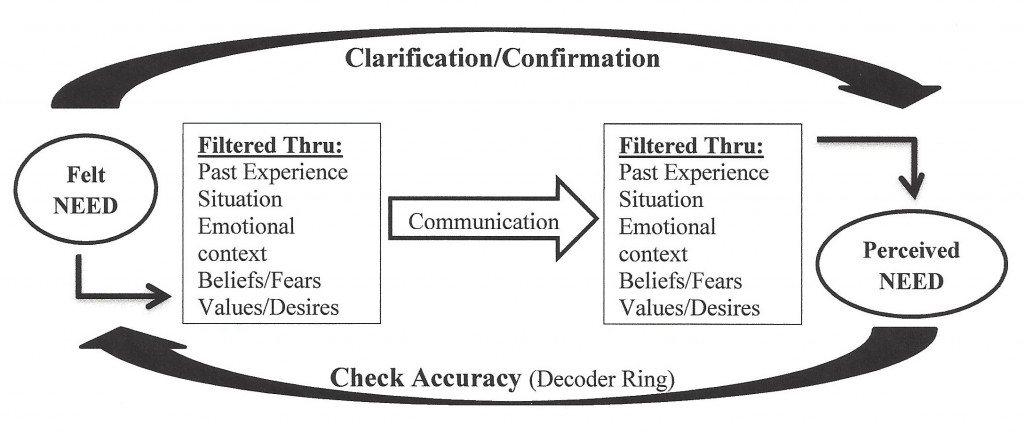A Communication Decoder Ring for You
Family communication is not the simple process I once thought. I’ve decided I need a communication decoder ring. I say something to my spouse or children and think they’ll understand it…but they don’t. What I want to say gets filtered before I speak. Then, what the listener hears gets filtered before they understand. The whole process might look something like this (adapted from Thomas Gordon’s model):
As you can see, communication is much more complicated than I once thought. Briefly look at each of the filters involved in our communication attempts.
- Past Experience. When my daughters were preschoolers, my wife would say, “I’m going to put the girls down now.” The first time I heard her make this statement I felt the need to run to my daughters and protect them. My past experience included working in a dog cemetery and “putting the girls down” meant something different than getting them ready for a nap! Perhaps you or your spouse has a history of feeling neglected and ignored, misunderstood or blamed. This history may impact how you hear and understand simple statements.
- Situation. Recently my wife told my daughter she was “going to have to sell yourself.” Wait, before you think we are going to extremes trying to pay for college, let me explain the situation. We were discussing how my daughter could get more babysitting jobs or a position as nanny for the summer. She needed to get her name out there. Let people know she was available to help with children…she needed to “sell herself.” The situational context of a statement or question can really impact how it is understood.
- Emotional Context. Did you ever come home exhausted from work and, as soon as you enter the door, your spouse asks about the one project you have not yet completed? Any other time you would simply answer the questions. But in your emotional state of exhaustion and fatigue, you hear the question as an accusation. The emotional desire for rest is squelched by the question and you snap back with a response that underscores an implicit message of “leave me alone!” The emotional context, your emotional state, impacted how you received the message. On the other hand, your spouse’s emotional state may have impacted the tone with which the message was given as well.
- Beliefs and Fears. If you believe your spouse will answer negatively, you may word your question differently. For instance, you might say, “You don’t want to sit with me, do you?” rather than “Do you have time to sit with me?” If you fear being misunderstood, your simple explanation may expand into a lecture that no one will listen to. Beliefs about emotion offer another example of the power of belief filters to impact communication. Those who avoid emotions will less likely express them. Those who believe emotions reveal weakness may look down on or dismiss emotional expression.
- Values and Desires. We all desire respect. We have a need for acceptance. The level of that need at any given moment may filter our communication.
With these filters operating on both the speaker and the listener, it’s a wonder we’re ever understood. We really do need a decoder ring to get through the maze of filters to communicate effectively. Fortunately, I know a simple decoder ring that I can describe to you right here. A simple one act process: get curious and ask for clarification. “What can I do for you?” “What do you need?” “Do you mean to say…?” A little bit of curiosity and a simple question can decode the communication maze and bring a new level of intimacy into your family relationships. It sounds too simple, too good to be true. Nonetheless, you will find this decoder ring very effective. Ask for clarification. Give it a try over the next week and observe how your communications improve.

-0 Comment-